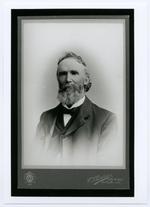The content consists of Robert Williamson's diary January 1888- December 1914 (typescript transcript with index included), recording his business affairs, property transactions, political career and his involvement of Laxey Village affairs (the harbour breakwater, Snaefell railway, Laxey school, fishing fleets etc.). Another diary belonging to his daughter Edith shows a detailed account of a trip to Paris in 1899 (typescript transcript included). Other material includes a typescript biography of Robert Williamson, typescript transcripts of Isle of Man press obituaries of Robert Williamson and typescript biographies of Williamson's children. Further material includes a family tree of the Williamsons, genealogical notes and typescripts for census records (1841-1881) with entries for family members living in the eastern parish of Lonan, Isle of Man.
Diaries of Robert Williamson of Laxey and his daughter Edith, with accompanying biographical notes on family members
This material is held atManx National Heritage Library and Archives
- Reference
- IM 147 MS 10019
- Dates of Creation
- 1888-1995
- Name of Creator
- Language of Material
- English
- Physical Description
- 1 volume & 1 folder
- Digital Content
Scope and Content
Administrative / Biographical History
Robert Williamson (1841-1927), born in east coastal village of Laxey, Isle of Man, and was the son of Scottish parents James Williamson (c.1806-1865) and (Grizel) Grace née Dick (c.1807-1877). Moving from Ayrshire, Scotland to the Isle of Man in the late 1830s, the Williamson family settled in the eastern parish of Lonan and ran a general business in the village of Laxey. After finishing school, Robert gained an apprenticeship to Mr J. J. Corlett, a cabinet maker in Ramsey. Completing his apprenticeship in 1861 Robert returned to Laxey and worked in the family business until 1866. Afterwards he decided to conduct his own enterprise, opening a general store in 'Upper' Laxey he benefitted from the busy trade by Laxey's mining industry. In 1864 he married Eunice Caine (c.1837-1865) from Baldwin. She died in childbirth and their twin daughters, Frances (1865-1865) and Eunice (1865-1866) did not survive infancy.
In 1867 Robert married Mary Fraser (c.1845-1887) in Liverpool, England, producing nine children; Mary Anne (1868-1869), Edith Alice (Corlett 1871-1954), Robert (1873-1950), Isabella (Senogles, 1874-1955), Agnes (1876-1894), James (1877-c.1940), Annie Gertrude (1878-1893), Elizabeth Grace (Williamson 1880-1911) and David (1881-1955). In 1868 Robert acquired a house and land from Captain Richard Rowe (c.1823-c.1886) of the Great Laxey Mining Company. Over time Robert developed the land into the Laxey Glen Gardens (first known as Victoria Park), transforming the village into a popular holiday destination, fuelling the ever expanding tourist industry on the Island. The gardens provided employment for many villagers. Visitors were attracted by the beautiful scenery, a hotel (built at the entrance to the grounds), a dance floor and a restaurant. For the hotel and restaurant, Robert built a kitchen garden and its own bake house; other produce was supplied by the butchery and grocery shops Robert owned alongside his general store business.
In 1887 Robert was widowed a second time and in 1890 he married a third time to Agnes Morton (1866-1946) in Perth, Scotland. The couple had five children: William Morton (1892-1962), John Richmond (1894-1911), Helen May (1896-1989), Alexander (1902-1977) and Stuart (1903-1977). In the 1890s Robert's business empire expanded to Douglas to include a wholesale business and retail shops situated on Prospect Hill and Athol Street, ran successfully until 1927. As Robert's businesses grew, so too did their locations; in 1896 he sold the land that housed the bake house to the Manx Electric Railway (they were constructing the Snaefell line), rebuilding it opposite his bakery store. In 1900 he constructed a new grocery store in front of the (new) bake house, while the old grocery store was used as offices, a newsagent and a boots store, with an aerated water factory in the basement. Further expanding Laxey as a tourist destination, Robert bought land at South Cape (Laxey) and on Laxey beach, selling each plot for the erection of buildings suitable for visitors. He acquired 'The Lhergy' (meaning slope) on the Gretch-Voar estate, Laxey, calling it 'Sunnycroft' and transformed the area by building several villas and bungalows for his immediate family. In 1922 Robert's final business venture saw him purchase the Great Laxey Mining Company, providing employment and preservation of the community's life until its final closure in 1929.
Alongside his business activities, Robert paid particular attention to village and Island affairs: he was an original member of the board of Laxey Village Commissioners, a member and secretary to the first elected School Board of Lonan and in 1891 was a Member of the House of Keys (MHK) for the sheading of Garff. Brought up in the Methodist Church, later in life Robert was a member of St Andrew's Presbyterian Church, Douglas but he still showed devotion to the Methodist Church on Minorca Hill, Laxey. Robert died at the age of 86 and is buried in Lonan Churchyard.
Access Information
No regulations or restrictions are implemented on this material.
Advance notification of a research visit is advisable by emailing library@mnh.gov.im .
Archivist's Note
The biographical information was gathered from Dollin Kelly's (ed.) New Manx Worthies (2006: 462-464) and the Manx newspaper the Isle of Man Examiner (11 March 1927 & 18 March 1927). Isle of Man newspapers available online at http://www.newspapers.gov.im/Default/Skins/IOMDemo/Client.asp?skin=IOMDemo&enter=true&AppName=2 .
Fonds-level description created by Eleanor Williams (MNH Project Archivist), February 2016.

